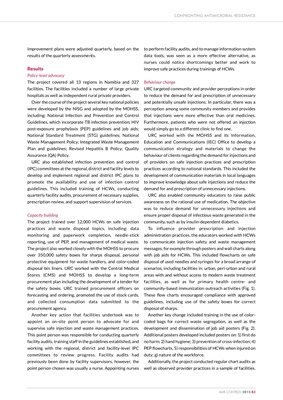
Improvement plans were adjusted quarterly, based on the
results of the quarterly assessments.
Results
Policy-level advocacy
The project covered all 13 regions in Namibia and 327
facilities. The facilities included a number of large private
hospitals as well as independent rural private providers.
Over the course of the project several key national policies
were developed by the NISG and adopted by the MOHSS,
including: National Infection and Prevention and Control
Guidelines, which incorporate TB infection prevention; HIV
post-exposure prophylaxis (PEP) guidelines and job aids;
National Standard Treatment (STG) guidelines; National
Waste Management Policy; Integrated Waste Management
Plan and guidelines; Revised Hepatitis B Policy; Quality
Assurance (QA) Policy.
URC also established infection prevention and control
(IPC) committees at the regional, district and facility levels to
develop and implement regional and district IPC plans to
promote the availability and use of infection control
guidelines. This included training of HCWs, conducting
quarterly facility audits, procurement of necessary supplies,
prescription review, and support supervision of services.
Capacity building
The project trained over 12,000 HCWs on safe injection
practices and waste disposal topics, including: data
monitoring and paperwork completion, needle-stick
reporting, use of PEP, and management of medical waste.
The project also worked closely with the MOHSS to procure
over 350,000 safety boxes for sharps disposal, personal
protective equipment for waste handlers, and color-coded
disposal bin liners. URC worked with the Central Medical
Stores (CMS) and MOHSS to develop a long-term
procurement plan including the development of a tender for
the safety boxes. URC trained procurement officers on
forecasting and ordering, promoted the use of stock cards,
and collected consumption data submitted to the
procurement agency.
Another key action that facilities undertook was to
appoint an on-site point person to advocate for and
supervise safe injection and waste management practices.
This point person was responsible for conducting quarterly
facility audits, training staff in the guidelines established, and
working with the regional, district and facility-level IPC
committees to review progress. Facility audits had
previously been done by facility supervisors, however, the
point person chosen was usually a nurse. Appointing nurses
to perform facility audits, and to manage information system
data tools, was seen as a more effective alternative, as
nurses could notice shortcomings better and work to
improve safe practices during trainings of HCWs.
Behaviour change
URC targeted community and provider perceptions in order
to reduce the demand for and prescription of unnecessary
and potentially unsafe injections. In particular, there was a
perception among some community members and provides
that injections were more effective than oral medicines.
Furthermore, patients who were not offered an injection
would simply go to a different clinic to find one.
URC worked with the MOHSS and its Information,
Education and Communications (IEC) Office to develop a
communication strategy and materials to change the
behaviour of clients regarding the demand for injections and
of providers on safe injection practices and prescription
practices according to national standards. This included the
development of communication materials in local languages
to improve knowledge about safe injections and reduce the
demand for and prescription of unnecessary injections.
URC also enabled community educators to raise public
awareness on the rational use of medication. The objective
was to reduce demand for unnecessary injections and
ensure proper disposal of infectious waste generated in the
community, such as by insulin-dependent diabetics.
To influence provider prescription and injection
administration practices, the educators worked with HCWs
to communicate injection safety and waste management
messages, for example through posters and wall charts along
with job aids for HCWs. This included flowcharts on safe
disposal of used needles and syringes for a broad arrange of
scenarios, including facilities in: urban, peri-urban and rural
areas with and without access to modern waste treatment
facilities, as well as for primary health centre- and
community-based immunization outreach activities (Fig. 1).
These flow charts encouraged compliance with approved
guidelines, including use of the safety boxes for correct
disposal of sharps.
Another key change included training in the use of colorcoded
bags for correct waste segregation, as well as the
development and dissemination of job aid posters (Fig. 2).
Additional posters developed included posters on: 1) first do
no harm; 2) hand hygiene; 3) prevention of cross-infection; 4)
PEP flowcharts, 5) responsibilities of HCWs when injured on
duty; g) nature of the workforce.
Additionally, the project conducted regular chart audits as
well as observed provider practices in a sample of facilities.
CONFRONTING ANTIMICROBIAL RESISTANCE
AMR CONTROL 2015 83